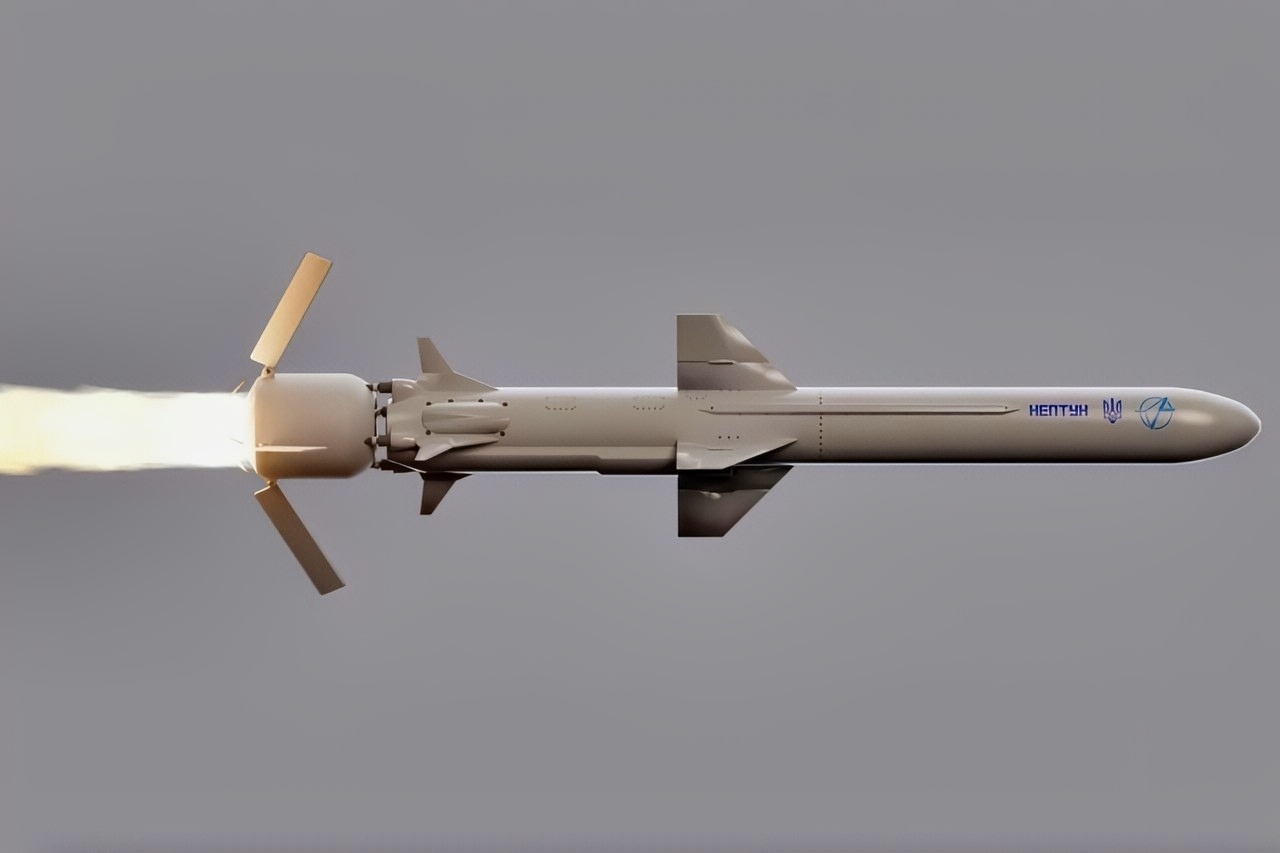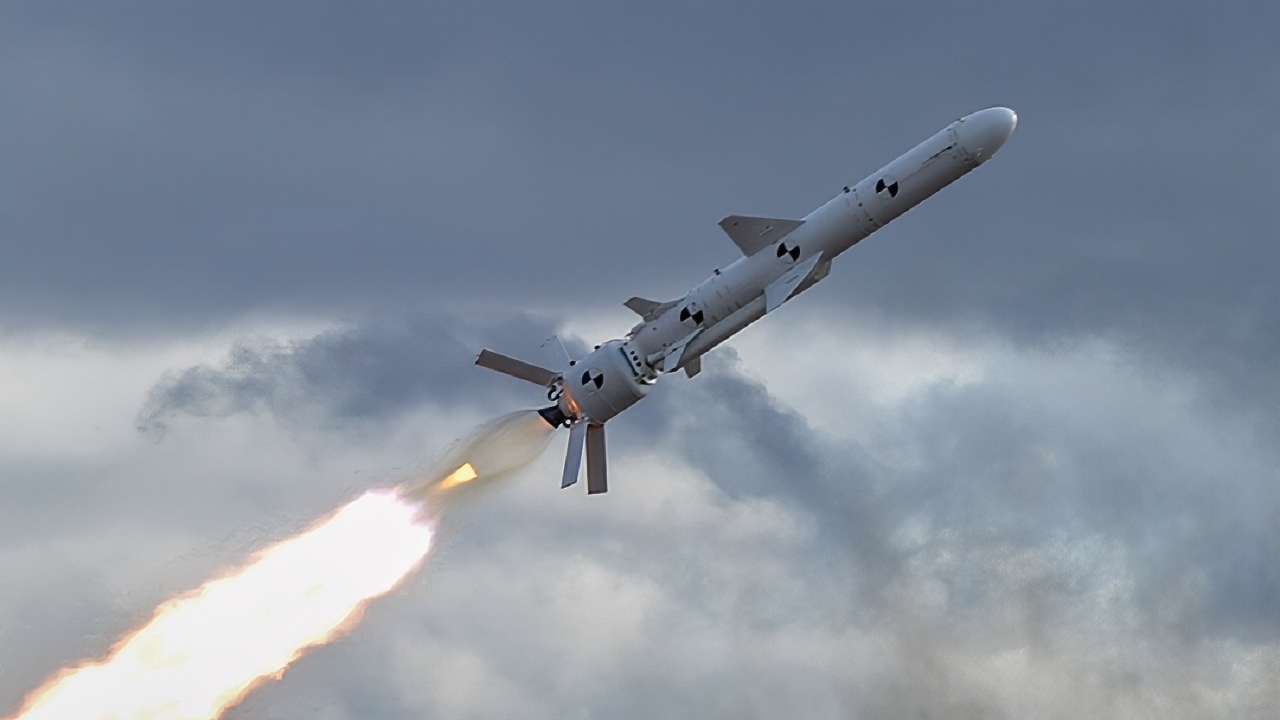WARSAW, POLAND – Ukraine has again surprised the international missile design community by taking the wraps off a new version of the R360 Neptune anti-ship missile (ASM).
On October 7, this previously unknown version of the missile was shown and demonstrated to an official delegation from Lithuania, a NATO member in the Baltic.

Neptune Missile. Image Credit: Government of Ukraine.
The Ukrainian defense website Militarnyi reports that the Ukraine Ministry of Defense, specifically the Defense Minister Denys Shmyhal, presented the new Neptune design to the Lithuanian delegation. Shmyhal later posted images of the Neptune, along with a series of other Ukrainian-designed weapon systems shown to this delegation.
In addition to the new Neptune variant, the delegation was also shown the Peklo aerial drone, the Magura V7 naval underwater unmanned drone, and other domestically-produced defense equipment.
The Neptune missile and the word “surprise” have long been associated together, making the new version of the missile stand out from all the other weaponry shown to the Lithuanians.
The world of naval analysts and surface warfare specialists was shocked in April 2022 when Ukraine’s homegrown-design and domestically-produced R360 Neptune anti-ship missile (ASM) sank the flagship of the Russian Black Sea fleet, the cruiser Moskva.
This use was the missile’s first “recorded kill” and is regarded as one of the most serious combat losses of a major naval vessel by any navy in decades.
Following the initial success of this missile, the design team for the program got to work adapting its use for multirole missions, including surface-to-surface attack and anti-ship targeting. This required a redesign of the seeker, guidance system, and other sections of the missile as well.
September and October Surprises
One of the earlier examples of developing new versions of the missile for differing missions came in September 2023, when a Neptune destroyed one of the Russians’ most modern (and most expensive) air defense systems in Crimea, the Almaz-Antei S-400 after action assessments were that the Ukraine design team were able to assess where the S-400 was compromised by “blind spots” in its sensor array that made it difficult for its surveillance radar to see the incoming Neptune and shoot it down before it was within terminal phase range.
The Defense Minister’s presentation of the new Neptune version did not reveal any detailed technical specifications of the missile.
Still, the released images show visible external differences compared to earlier versions.
The Lithuanian visit and the revelation of the new design highlighted that the advanced modifications of the missile are taking place despite an ongoing Russian invasion of Ukraine.
Moscow is continuing to launch swarms of drones and ballistic missile attacks on Ukrainian cities almost daily, but the design team’s work continues nonetheless.
While Russian Vladimir Putin is making war on Ukraine’s civilian population, Ukraine’s armed forces are degrading Russian fuel production and logistics by hitting Moscow’s oil refineries and railway infrastructure. Most of these strikes are carried out using domestically produced long-range drones rather than cruise missiles like the R360.
In a perfect world, Ukraine would be using advanced versions of the Neptune to take out these strategic targets. But Ukraine’s manufacturing capacity for this missile is still limited. Only about 50 of these missiles were launched over the past year due to a lack of manufacturing capacity in Ukraine.
The Newest Neptune Variant
According to the Militarnyi reports, the missile that was shown to the Lithuanian delegation reveals some significant design changes.
These include two bulging blivets on the side of the missile’s fuselage. No one from the MoD, the Defense Ministry, revealed their exact purpose.
Still, National Security Journal has since confirmed that these are conformal fuel tanks that provide the missile with extended range.
Significant effort has been expended to extend the range of the Neptune, and in August 2025, an extended-range modification of the missile was revealed. This variant was called the “Long Neptune” or Neptune-MD. This modernization of the missile featured larger dimensions due to the additional internal fuel, which increased its diameter and total length.
The Neptune-MD was also fitted with a 260 kg warhead, which is 110 kg more than the anti-ship version of the Neptune, and its operational range increased to 1000 km.
This compares with a 280 km range for the original anti-ship variant. The missile’s body length measures 6 meters, not including the booster motor, and the diameter is now 50 centimeters.
This latest version of the missile is now equipped with a modernized guidance system.
This allows the missile to be guided during the intermediate phase of flight using an improved satellite positioning system, which increases accuracy by reducing the circular error probability (CEP) to ensure target destruction.
The final stage of the flight is facilitated by an infrared homing system, which enhances the effectiveness of the kill even when the missile is in a dense electronic warfare environment.
The Defense Minister Denys Shmyhal stated that Ukraine’s manufacturers have demonstrated “ready solutions that strike the enemy at the front and in the rear.”
He added that Ukrainian manufacturers present designs that “can already be produced tomorrow in partner countries within the Build with Ukraine program.”
About the Author: Reuben F. Johnson
Reuben F. Johnson has thirty-six years of experience analyzing and reporting on foreign weapons systems, defense technologies, and international arms export policy. Johnson is the Director of Research at the Casimir Pulaski Foundation. He is also a survivor of the Russian invasion of Ukraine in February 2022. He worked for years in the American defense industry as a foreign technology analyst and later as a consultant for the U.S. Department of Defense, the Departments of the Navy and Air Force, and the governments of the United Kingdom and Australia. In 2022-2023, he won two awards in a row for his defense reporting. He holds a bachelor’s degree from DePauw University and a master’s degree from Miami University in Ohio, specializing in Soviet and Russian studies. He lives in Warsaw.
More Military
Canada’s F-35 Fighter Program Has Passed the Point of No Return
USS Oriskany: The Navy Essex-Class Aircraft Carrier That Was Sunk On Purpose
Nimitz-Class Nuclear Aircraft Carrier USS John C. Stennis ‘Out Action’ for 5 Years
Australia’s Mogami-Class Frigate Buy from Japan Is a Big Deal
The F-14 Tomcat Fighter Could Stop Enemy Tanks In Their Tracks










